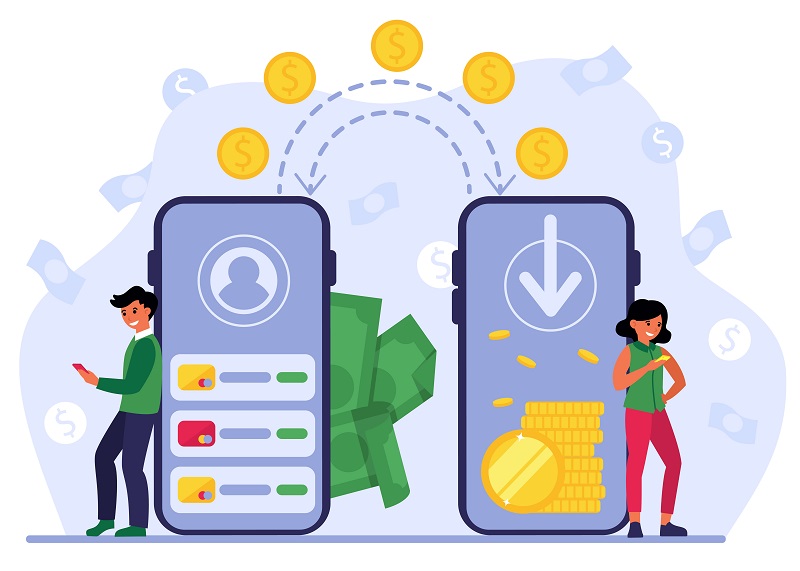P2P payments have simplified paying and sending money, no matter where you are, whether you’re sharing the bill, sending money to family across the pond, or paying your bills. The best peer-to-peer-payment apps have gained popularity as a result of how convenient and simple they are for consumers to use. You can send and receive money almost immediately with only a few taps.
How do you determine which of the many P2P payment apps for Android and iOS users best meets your needs? What advantages and disadvantages should you be aware of before selecting a P2P payment system? Let’s find out.
6 Best Peer-to-Peer Payment Apps
Which peer-to-peer payment app should you choose from the wide range of options available? Some of the experts who are well-experienced in P2P payment app development have helped us list down the best apps.
- Zelle
Users must first set up an account in order to use Zelle. When opening a Zelle account, users have two choices: through the app or through their individual banks. By providing their email address or phone number once they are set up, users of Zelle can quickly send or request money from other users. The app is simple to use on its own.
Users who want to send and receive money in their bank accounts immediately (for domestic transactions) should utilize Zelle. The majority of the nation’s biggest banks and credit unions are also compatible with this P2P technology, enabling smooth transactions. For now, Zelle is only accessible to Americans with US bank accounts in the US.
- PayPal
One of the best peer-to-peer payment apps is PayPal. If you’ve ever made an online purchase, you’re undoubtedly already familiar with PayPal’s range of payment options. Did you realize you could use it for both online purchases and peer-to-peer payments? Individual users can send money to one another through the PayPal app using linked credit cards, debit cards, and bank accounts. Find the person’s username, name, email address, or phone number to send or request money.
The large transfer limits offered by PayPal are a significant benefit. PayPal’s sending restrictions are fairly huge – up to £5,500 for a single transaction – in contrast to many of the finest peer-to-peer payment programs, which have much lower caps. The disadvantage is that, unlike some other options on this list, transfers don’t happen instantly, and you have to pay transaction costs.
- Apple Pay Cash
Mobile payments to both businesses and consumers are possible thanks to Apple’s digital wallet. When combined with the standard Apple Pay app, the Apple Pay Cash app enables users to send and receive money using Messages. Users can utilise the Apple Wallet app to attach a credit or debit card to their account and join up with Apple Pay. If your device supports NFC transactions, you can use Apple Pay to make purchases from a range of merchants. Because it is incompatible with Android devices, Apple Pay Cash works best if your friends and family are also Apple users.
- Cash App
Block Inc. invented the money transfer app called Cash App, which enables users to send money using their Cash App balance, a linked bank account, a credit card, or a debit card. Users can spend the money on their Cash App balance as well as earn “cash boosts,” which are discounts that are applied to different vendors, with the use of the service’s optional debit card, the Cash Card.
Cash app is similar to Moneylion app. You can also understand about that app and develop apps like Moneylion for allowing users to send and receive money. After downloading the Cash App to their smartphone or tablet, users create an account and link their cards or bank accounts. Once they’ve created their Cash App account, they’ll be able to purchase and sell bitcoin, send and request money from other Cash App users, and invest in stocks.
- Venmo
Venmo is owned by PayPal, which also manages it, but the two P2P payment services are autonomous. With the ability to send emojis and messages along with payments, Venmo gives transactions a social component. The global feed was removed from the app in July 2021, however you can still view the payment stream for your Venmo buddies. You can also choose to make your payments secret if you’d like.
Debit cards, bank accounts, and credit cards can all be connected to a Venmo account. You can also set up direct deposits, and the funds you receive are held in your Venmo account. Then, within one to three business days, it can be transferred to a linked bank account; fast transfers (within 30 minutes) can be possible for a fee.
- Google Pay
With the help of a digital wallet, users of the payment software Google Pay can make purchases and send money to others. Users of Android (running Android Lollipop 5.0 or higher) and Apple (running iOS 7 or higher) devices can download the Google Pay app, which enables them to send money to one another as well as make purchases from retailers who have a point-of-sale near-field communication reader.
The app must be downloaded, followed by a Google account sign-in and the linking of payment and banking details. They will then have the ability to send money and make payments. Users of Google Pay can also divide expenses with one another for things like rent, utilities, and dining out, and the app offers math assistance.
Conclusion
Here is our list of the 6 best peer-to-peer payment apps in the globe according to download volume. All of these apps offer a great substitute for sending money abroad using non-banking channels. Additionally, you can typically send money promptly and without charge. Just remember to carefully read the fine print before selecting any P2P payment platform whether there are any fees or other relevant details. A leading app development company provides scalable app solutions across the globe.
